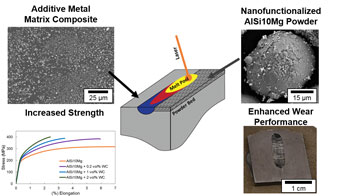Crossref Citations
This article has been cited by the following publications. This list is generated based on data provided by
Crossref.
Mussatto, Andre
Groarke, Robert
A-Hameed, Ahmed
Ahad, Inam U.I.
Vijayaraghavan, Rajani K.
O'Neill, Aidan
McNally, Patrick
Delaure, Yan
and
Brabazon, Dermot
2019.
Evaluation via powder metallurgy of nano-reinforced iron powders developed for selective laser melting applications.
Materials & Design,
Vol. 182,
Issue. ,
p.
108046.
Nezafati, Marjan
Bakhshinejad, Ali
Church, Benjamin
and
Rohatgi, Pradeep
2019.
TMS 2019 148th Annual Meeting & Exhibition Supplemental Proceedings.
p.
339.
Lin, Linhan
Kollipara, Pavana Siddhartha
and
Zheng, Yuebing
2019.
Digital manufacturing of advanced materials: Challenges and perspective.
Materials Today,
Vol. 28,
Issue. ,
p.
49.
Norrell, Travis
Ferguson, Gehn
Ansell, Troy
Saladin, Tara
Nardi, Aaron
and
Nieto, Andy
2020.
Synthesis and corrosion behavior of cold sprayed dual nanoparticle reinforced Al coatings.
Surface and Coatings Technology,
Vol. 401,
Issue. ,
p.
126280.
Poorganji, Behrang
Ott, Eric
Kelkar, Rajandra
Wessman, Andrew
and
Jamshidinia, Mahdi
2020.
Review: Materials Ecosystem for Additive Manufacturing Powder Bed Fusion Processes.
JOM,
Vol. 72,
Issue. 1,
p.
561.
Sahini, Deepak Kumar
Ghose, Joyjeet
Jha, Sanjay Kumar
Behera, Ajit
and
Mandal, Animesh
2020.
Additive Manufacturing Applications for Metals and Composites.
p.
187.
dos Santos, Tiago
and
Vadillo, Guadalupe
2021.
A closed-form yield criterion for porous materials with Mises–Schleicher–Burzyński matrix containing cylindrical voids.
Acta Mechanica,
Vol. 232,
Issue. 4,
p.
1285.
Vafadar, Ana
Guzzomi, Ferdinando
Rassau, Alexander
and
Hayward, Kevin
2021.
Advances in Metal Additive Manufacturing: A Review of Common Processes, Industrial Applications, and Current Challenges.
Applied Sciences,
Vol. 11,
Issue. 3,
p.
1213.
Molla‐Hosseini, Mojtaba
Hosseini, Marjan
Vossoughi, Gholamreza
and
Sharifzadeh, Mahdi
2022.
Industry 4.0 Vision for Energy and Materials.
p.
339.
Neef, Philipp
Bernhard, Robert
Wiche, Henning
and
Wesling, Volker
2022.
Generative Manufacturing of Optical, Thermal and Structural Components (GROTESK).
p.
77.
Beer Mohamed, S.
Kaviarasu, C.
Danielwillson, A.
Velmurugan, C.
Jayaganthan, R.
and
Kaviyarasu, K.
2022.
Nanomaterials for Energy Conversion, Biomedical and Environmental Applications.
p.
167.
Rometsch, Paul A.
Zhu, Yuman
Wu, Xinhua
and
Huang, Aijun
2022.
Review of high-strength aluminium alloys for additive manufacturing by laser powder bed fusion.
Materials & Design,
Vol. 219,
Issue. ,
p.
110779.
Shabalin, Igor L.
2022.
Ultra-High Temperature Materials IV.
p.
11.
Ge, Jun
Pillay, Selvum
and
Ning, Haibin
2023.
Post-Process Treatments for Additive-Manufactured Metallic Structures: A Comprehensive Review.
Journal of Materials Engineering and Performance,
Vol. 32,
Issue. 16,
p.
7073.
Mehta, Bharat
Mishurova, Tatiana
Evsevleev, Sergei
Markötter, Henning
Bruno, Giovanni
Hryha, Eduard
Nyborg, Lars
and
Virtanen, Eero
2023.
Microstructure, mechanical properties and fracture mechanisms in a 7017 aluminium alloy tailored for powder bed fusion – laser beam.
Materials & Design,
Vol. 226,
Issue. ,
p.
111602.
Wilms, Markus B.
Rittinghaus, Silja-Katharina
Goßling, Mareen
and
Gökce, Bilal
2023.
Additive manufacturing of oxide-dispersion strengthened alloys: Materials, synthesis and manufacturing.
Progress in Materials Science,
Vol. 133,
Issue. ,
p.
101049.
2024.
Metallic Powders for Additive Manufacturing.
p.
179.
Goßling, Mareen
Rittinghaus, Silja-Katharina
Bharech, Somnath
Yang, Yangyiwei
Wilms, Markus B.
Becker, Louis
Weber, Sebastian
Xu, Bai-Xiang
and
Gökce, Bilal
2024.
Towards enhancing ODS composites in laser powder bed fusion: Investigating the incorporation of laser-generated zirconia nanoparticles in a model iron–chromium alloy.
Journal of Materials Research,
Vol. 39,
Issue. 5,
p.
774.






